10 Best Audio Interfaces Under $1,000
What are the best audio interfaces? This Icon Picks roundup features ten pro sounding audio interfaces under $1,000. It also offers buying tips and considerations.
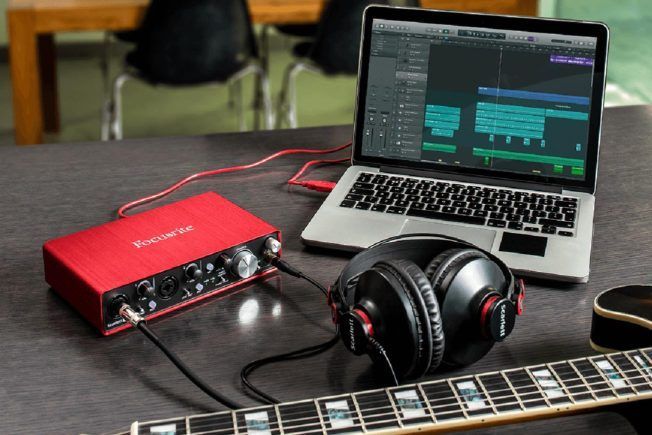
Why Audio Interfaces are Important
An audio interface is an essential piece of gear for any music recording studio or mobile musician. However, there are a variety of high-quality studio interfaces available. It can become overwhelming weighing the differences between options and knowing which features best fits your needs. There are different input and output configurations, connection types, formats, and other options to consider.
To help narrow down the extensive selection, we rounded up ten pro sounding audio interfaces. This buyers guide will help you choose the best audio interface for an affordable price.
What is an Audio Interface?
An audio interface is the hub of a modern recording studio. It connects your studio monitors, headphones, microphones, instruments, and other gear to your computer. They also provide high-resolution audio A/D and D/A conversion for music production and DJing.
For example, an audio interface converts analog signals from a microphone or instrument into digital audio signals your computer can process. This audio conversion also performs the same process in reverse. Digital audio signals from your computer convert into analog signals heard through your studio monitors or headphones.
Many audio interfaces also provide preamps, metering, and other features for recording or tracking audio.
Features to Consider When Buying an Audio Interface
Understanding how audio interfaces work, and the various features will help you make an informed buying decision.
Input/Output (I/O)
The number of inputs and outputs you need depends on your set up. For example, at least two balanced line outputs are necessary to connect studio monitors. If you DJ with a computer, consider an audio interface with four line outputs. Two outputs that connect to the house sound system, and two outputs to cue songs. The number of inputs also depends on how many devices you want to connect and record simultaneously.
Common Audio Interface I/O:
- XLR Inputs for Microphones – Most mic inputs also have a +48v switch that applies “phantom” power to condenser microphones. Some interfaces also include microphone preamps that boost the signal, add clarity, and inject character.
- Line Input – 1/4″ input to plug in instruments, effects processors, or a mixing board.
- Instrument-Level Input (Hi-Z) – 1/4″ input to plug in a guitar or bass.
- Combo Inputs – Combines a 1/4″ TRS and XLR input to connect either a microphone or instrument.
- Headphone Jack – 1/4″ stereo output to connect headphones.
- Line Outputs – 1/4″ balanced outputs to connect powered studio monitors. Additional line outputs can also connect effects processors and other outboard gear.
- MIDI Input and Output – Connect MIDI keyboards, drum machines, controllers, and other instruments that transmit/receive MIDI data.
- Digital Inputs and Outputs – S/PDIF or ADAT ports to connect expanders, effects processors, and outboard gear with digital I/O.
Audio Interface Type
- Desktop – Perfect for a small project studio. Desktop interfaces offer essential features and fewer I/O’s for basic setups. Some are also bus powered, which makes them ideal for mobile use.
- Rackmount – Designed to fit into an audio equipment rack. Rackmount interfaces offer more I/O’s and signal routing flexibility. However, they are less accessible than desktop interfaces.
- Mobile – Designed for mobile use. Mobile interfaces are compact, have limited I/O’s, and offer simple controls.
Computer Connection Type
Choose an audio interface compatible with your computer’s data ports. Connect your computer to the interface with USB, USB-C, Thunderbolt, Firewire, PCIe or Ethernet.
Audio Latency
Latency is also an important consideration if you work with multiple plugins and high tracks counts. Latency is a delay caused by the time it takes audio to pass from the audio interface through your DAW and then back out. It takes time to convert and process the audio. Faster connection types will give you better performance.
Bit Depth and Sample Rate
The sample rate and bit depth define sound quality and resolution.
- Sample Rate – The number of samples per second in a piece of audio. It describes sound detail. Sample rates range from 44.1 kHz to 192 kHz. 192kHz will give you the highest resolution.
- Bit Depth – Describes the dynamic amplitude range. 24-bit recording is the pro-audio standard today. This bit depth will give you a higher level of fidelity while eliminating most noise.
Additional Considerations
Other features to look for are metering and included software packages. Newer audio interfaces also integrate software control and onboard DSP for mixing. Digital signal processing (DSP) provides integrated software mixers, audio effects, and monitoring. This technology reduces latency and CPU load.
1. Universal Audio | Apollo Twin MkII DUO
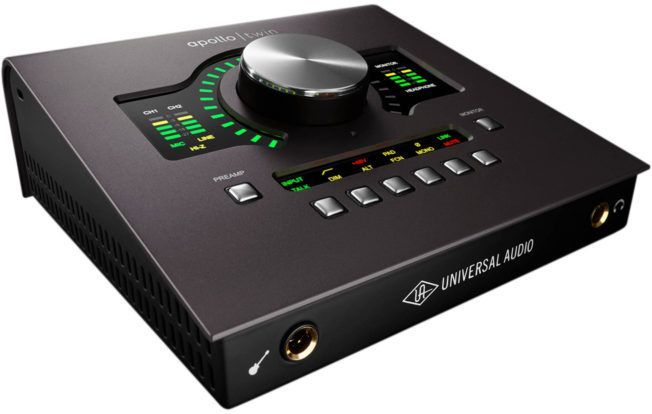
Apollo Twin MkII is a 10-in/6-out desktop Thunderbolt audio interface. It packs console functionality into a compact desktop unit. The new redesign brings two Unison enabled mic preamps and next-generation audio conversion used in their flagship Apollo interfaces. You also get access to the full range of UA’s DSP Powered Plugins. Mix with authentic analog emulations of iconic vintage recording gear!
2. Focusrite | Scarlett 2i4 (2nd Generation)
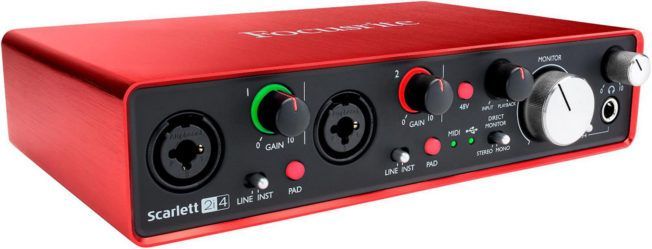
The Scarlett 2i4 is a compact 2-in/4-out USB audio interface. This second-generation Scarlett brings new upgrades. It features super-low latency, improved sample rates, enhanced sound quality, and more. Also, the industrial redesign gives you metal volume controls, and a sleeker red metal chassis built to go anywhere.
3. Audient | iD14
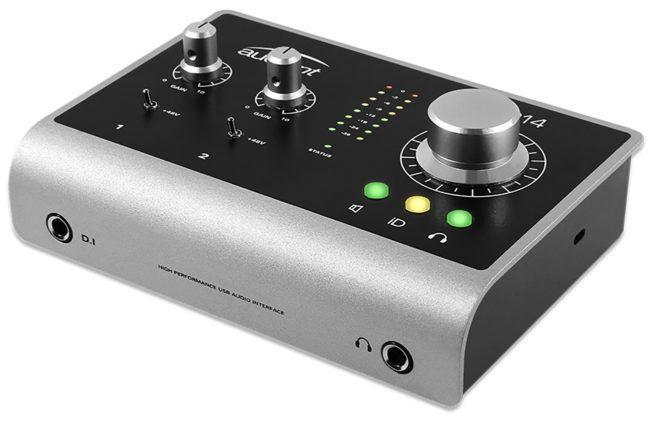
The Audient iD14 is a compact 10-in/4-out desktop USB audio interface. It sports two Class A mic preamps, Burr-Brown converter technology, console-style monitor control, and a JFET direct input. Also onboard is Audient’s ScrollControl mode. This virtual scroll wheel gives you control over compatible parameters within your DAW. Moreover, it delivers the high-quality sound of a large console in a compact desktop unit.
4. RME | Babyface Pro
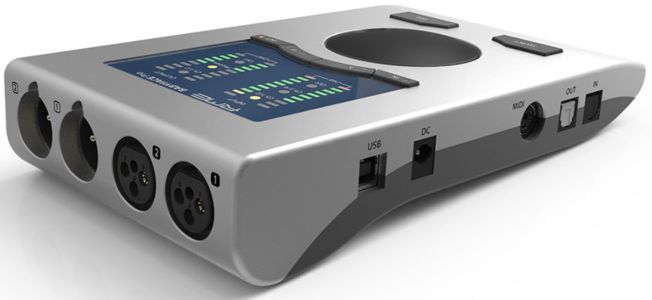
The Babyface Pro is a portable 12-in/12-out USB audio interface. This road-ready interface offers a low-profile aluminum casing, two high-quality mic preamps, two analog XLR outs, hi-Z, and lo-Z 1/4″ inputs, ADAT/SPDIF I/O, a MIDI port, and two separate headphone outputs. Also included is RME’s TotalMix FX software mixer, which gives you access to audio effects and routing. This unit is pricey, but it’s also possibly the best mobile interface on the market!
5. Native Instruments | Komplete Audio 2
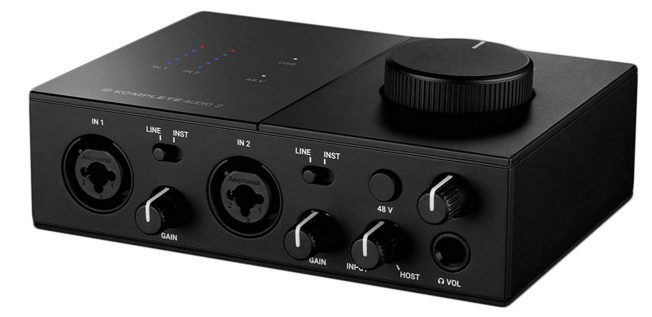
KOMPLETE AUDIO 2 is a new USB audio interface designed for the studio or the stage. This compact desktop interface is worth considering for those on a budget. It’s lightweight, affordable, and offers essential connections. The KOMPLETE AUDIO 2 also comes with Native Instruments’ Maschine Essentials, Komplete Start, the Monark synth, an effects suite, and Ableton Live 10 Lite.
6. Apogee | Element 24
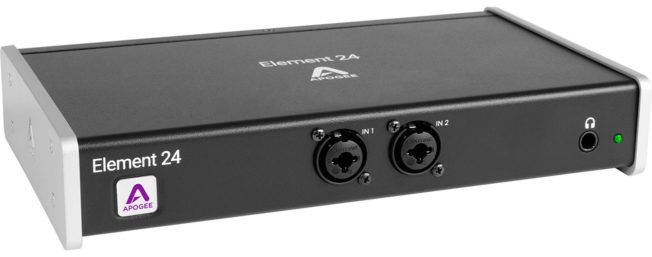
The Element 24 is a streamlined 10-in/12-out desktop Thunderbolt audio interface. It features two front-panel combo inputs, two rear-panel balanced XLR outputs, a stereo headphone out, and word clock I/O. Two of Apogee’s world-class mic preamps are also onboard, with selectable phantom power. Moreover, it comes with Apogee’s Element Control software. You can control the interface from your Mac or wirelessly with an iPhone, iPad, or iPod touch.
7. IK Multimedia | AXE I/O
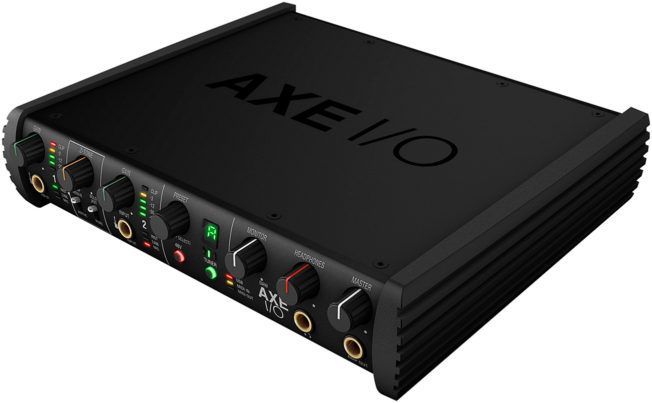
The AXE I/O is a compact 2-in/5-out desktop USB audio interface. Its design and features focus on recording guitarists. But it also works excellent for any music production set up. This versatile interface also has controller capabilities not found on other audio interfaces. Moreover, the AXE I/O is a fully-featured audio interface. It offers innovative features, tonal shaping controls, a variety of instrument input circuits, amp functions, a built-in tuner, and more. It also comes with AmpliTube 4 Deluxe software suite, T-RackS, and Ableton Live Lite.
8. PreSonus | Studio 26c
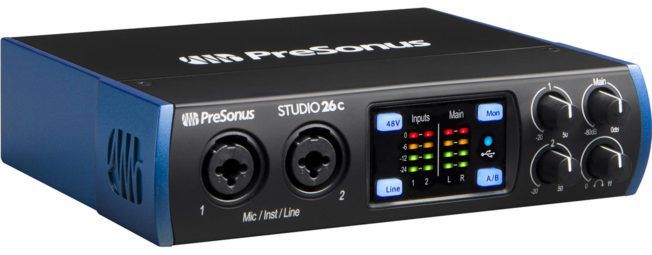
The Studio 26c is a portable 2-in/4-out desktop USB-C audio interface. It’s ideal for DJs, mobile musicians, and electronic musicians. It features mic/line/instrument inputs, DC-coupled line outputs, MIDI I/O, and a Cue Mix A/B button for DJs. The Studio 26c also comes with PreSonus’ award-winning Studio One Artist music production software.
9. Behringer | U-Phoria UMC404HD

The U-Phoria UMC404HD is an affordable 4-in/4-out desktop USB audio interface. This rugged interface is perfect for the studio or the stage. First, it incorporates MIDAS designed mic preamps. MIDAS has a long history of innovation and leadership in the world of audio mixing consoles. Second, it’s impact-resistant metal chassis, and Monitor A/B source select for DJ-style cueing makes it ideal for the road. Last, the U-Phoria UMC404HD comes with audio recording, editing, and podcasting software. It also includes 150 instrument/effect plugins.
10. Steinberg | UR-RT2
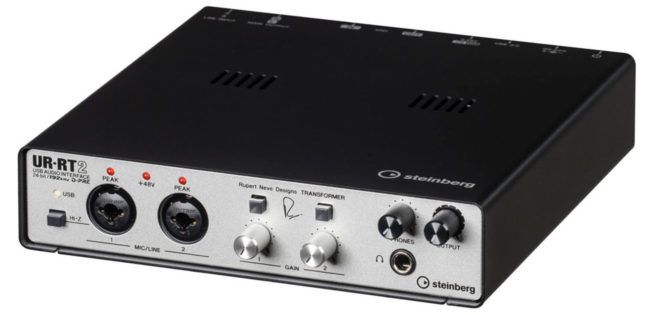
The UR-RT2 is a compact 4-in/2-out desktop USB audio interface. First, it gives you legendary Neve sound in a budget-friendly interface. The switchable Rupert Neve Designs transformers on the front inputs deliver a musical sound with rich harmonics. This feature is beneficial for vocals, acoustic guitar, and other instruments with an expressive dynamic range. It also offers studio-quality sound and a variety of I/O options for mobile musicians.
Honorable Mentions
There is a lot of excellent audio interfaces on the market. It makes it hard to narrow down the top ten. Below are ten more affordable audio interfaces worth considering:
1. Universal Audio Arrow
2. Focusrite Scarlett 2i2 (2nd Generation)
3. Focusrite Clarett 4Pre
4. Apogee Duet
5. Audient iD4
6. Audient Sono
7. IK Multimedia iRig Pro Duo
8. Arturia AudioFuse
9. Steinberg UR22mkII
10. MOTU UltraLite-mk4



